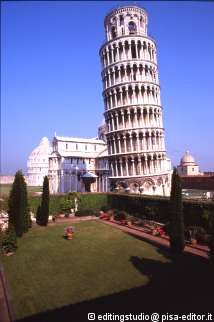The Leaning Tower of Pisa

The Leaning Tower of Pisa Leaning Tower of Pisa is a bell tower at Pisa, Italy. It is famous for leaning 141/2 feet (4.4 meters) out of line when measured from the seventh story. It tilts because its foundation was built on unstable soil (it's a well known fact that Pisa architects aren't so bright). Construction of the tower began in 1173 and ended between 1360 and 1370 (which means it's been around even longer than dad). The ground beneath the tower first started to sink after the first three stories were built. In 1990, the tower was closed for repairs. At that time, its lean had been increasing an average of 1/20 of an inch (1.3 millimeters) p er year. Engineers hope to stabilize the tower's foundation and straighten it slightly to prevent it from eventually collapsing and falling over (and yes, it is indeed open for tourists!). By 1994, their efforts had straightened the tower's lean about 2/5 of an inch (1 centimeter). No date for the reopening of the tower was scheduled. .
The Site
Leaving to one side the celebrated inclination - that daring challenge to the laws of statics - the bell tower of the Cathedral is a unique building of its kind, both for its great art historical value and for its peculiar situation, in the context of the vast and similarly unique area known as Piazza dei Miracoli. The To wer occupies a site to one side of the Cathedral, between the apsidal area and the sout h-eastern portion of the transept of the latter. Though not an isolated case (similar s patial organisations can be found in some Pisan complexes and in other Italian building s), this is an unusual collocation: normally, bell towers were built near to the fašade o r along one side of churches.
Here, however, the Tower assumes an unusual value through its dislocation from the other monuments in the area of Piazza dei Miracoli. The building is in fact sited in one of the most visible points of the Piazza, in correspondence with the junction between the latter and via Santa Maria, one of the antique thoroughfares of the city. Originally, a road which followed the course of via Emilia passed to the left of the Tower.
This road, which ran towards the apse and alongside the northern side of the Cathedral, continued beyond the city walls, through which it passed via the so-called porta de Leone - the Gate of the Lion. Furthermore, the contiguity between the Tower and the apsidal area of the Cathedral established a formal dialogue between the two buildings. This is reflected in the sculptural decoration of the ground floor of the Tower, in w hich motifs and elements to be found in the architecture of the Cathedral are used, while the circular form of the Tower would seem to relate to the curves of the Cathedral's two apses.
The Tower, with its great height, was a visual fulcrum, visible from all areas of the Piazza, and, probably, from the river Arno. In this way the Tower assumed the function of both connection between the city and the piazza, sited in a decentralised area of the urban nucleus, and beacon: a reference point and look-out and, ultimately, an authoritative symbol of the civic and religious pride of the Pisan community.
